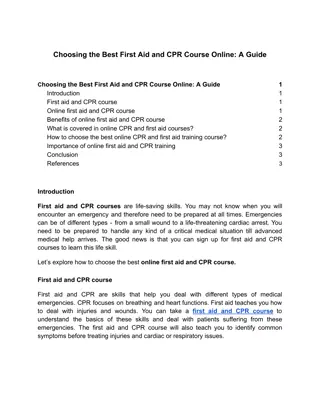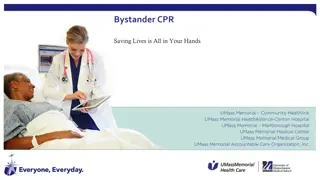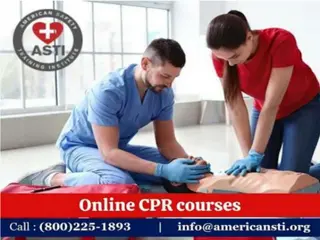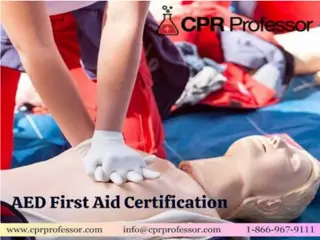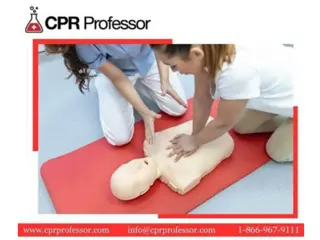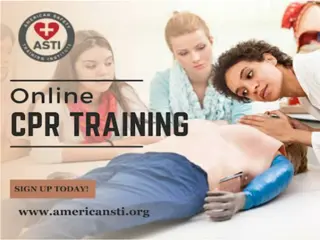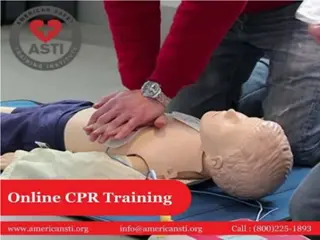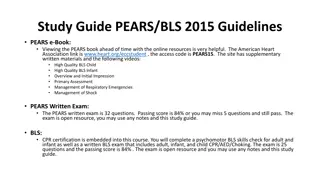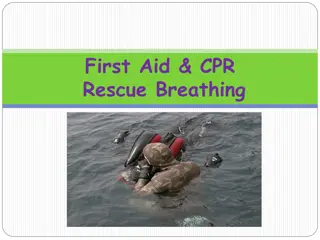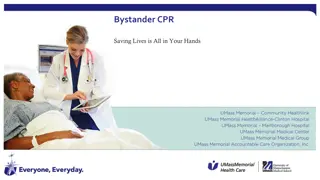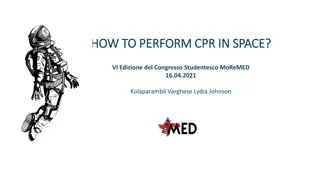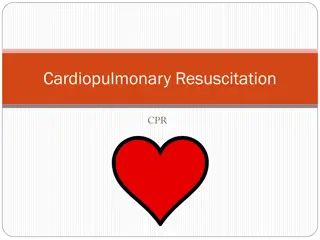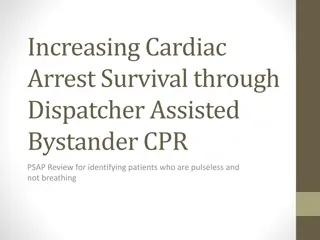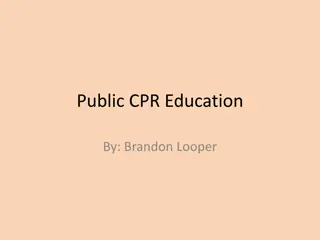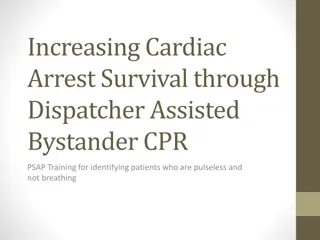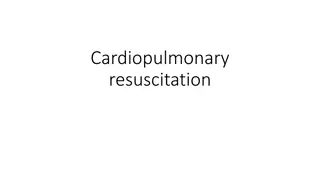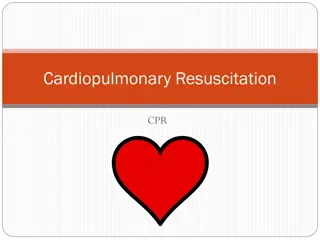
Veterinary CPR Update and Guidelines by Wendy Blount DVM
Dr. Wendy Blount, DVM, presents an insightful update on CPR practices for small animals in veterinary medicine. The article covers key aspects of preparedness, prevention, basic life support, advanced life support, monitoring, post-arrest care, and guidelines. It emphasizes the importance of proper equipment stocking, training, and addressing human errors for successful resuscitation outcomes.
Download Presentation

Please find below an Image/Link to download the presentation.
The content on the website is provided AS IS for your information and personal use only. It may not be sold, licensed, or shared on other websites without obtaining consent from the author. If you encounter any issues during the download, it is possible that the publisher has removed the file from their server.
You are allowed to download the files provided on this website for personal or commercial use, subject to the condition that they are used lawfully. All files are the property of their respective owners.
The content on the website is provided AS IS for your information and personal use only. It may not be sold, licensed, or shared on other websites without obtaining consent from the author.
E N D
Presentation Transcript
Wendy Blount, DVM CPR Update RECOVER
CPR Update RECOVER REassessment Campaign On VEterinary Resuscitation. Series of 7 articles in Journal of Veterinary Emergency and Critical Care GOALS evaluate the scientific evidence relevant to small animal CPR compose consensus-based clinical CPR guidelines for dogs and cats
CPR Update RECOVER 7 Parts 1 ABOUT RECOVER Materials & Methods 2 Domain 1 - PREPAREDNESS AND PREVENTION Domain 2 - BASIC LIFE SUPPORT (BLS) 3 Domain 3 - ADVANCED LIFE SUPPORT (ALS) 4 5 Domain 4 - MONITORING Domain 5 - POST ARREST CARE 6 CPR GUIDELINES All 5 domains 7
Wendy Blount, DVM Domain 1 Preparedness and Prevention
Pre-Stocked Arrest Areas Crash Carts use of both pre-stocked arrest stations and cognitive aids improves compliance with CPR protocols Most problematic are: missing equipment, lack of return to the cart incomplete stocking Inability to identify or locate needed medications Failure to have drugs and syringes in a quick, usable form Deficiencies and defects in resuscitation equipment Result - 18% delay in CPR in human medicine
Pre-Stocked Arrest Areas Crash Carts SOLUTIONS: Checklists and dated log sheet for restocking Regular re-training of staff Cognitive Aids improve outcome flow charts check lists Dose charts or calculators
Preparedness Prevention Arrest Outcome anesthesia-related CPAs and drug reactions have increased survival Survival rate of dogs and cats for CPA is between 4 and 9.6% Survival rate in human hospitals for CPA is 10-20% Human error plays a role in 91% of anesthesia deaths in people Post CPR debriefing identifies and corrects human error Veterinary studies 36-55% of CPAs occurring under anesthesia survive to discharge 0-3% of other CPAs survive to discharge Survive to discharge is much more important than successful resuscitation
Wendy Blount, DVM Domain 2 BLS Basic Life Support
Basic Life Support ABC Establish airway Ventilation (breathing) Chest compressions (circulation)
Basic Life Support Training CPR Team = Leader + 3 1. One person is the CPR Leader & record keeper 2. One person does chest compressions unless directed to stop by the Leader 3. One person establishes the airway and ventilates unless directed to stop by the leader 4. One person begins ALS, attaches monitors and carries out other tasks as instructed by the CPR Leader 5. The rest clear the room but the door is open to summon others standing by in case needed
Basic Life Support ABC Rapid recognition of CPA 1. Patient is unresponsive, pupils unresponsive 2. Absence of breathing (agonal does not count) 3. Absence of heart beat next slide 4. If in doubt, do chest compressions <2% adverse effects when done when not in CPA Rib fracture, tracheal bleeding, soreness 5. ECG checks confirm lack of effective circulation (q 2 min) 6. ETCO2 falls to near zero
Basic Life Support ABC Pulse Palpation to Detect CPA Femoral pulse is preferred Need corroborating evidence Lack of apical beat lack of an auscultable heartbeat No Doppler activity on pulse points or cornea (takes time) Presence of dorsal pedal pulse (metatarsus) confirms MAP >80mmHg
Basic Life Support ABC How to Assess Breathing Watch for chest excursions for at least 1 minute if respiratory rest only One hand lightly on the costochondral junction Fingers of the other hand in front of the nose at the same time There should be clocks on the walls in all areas that are high risk for CPA Surgery prep OR and areas for other anesthetic procedures Anesthesia Recovery ICU Clock on the crash cart is good, smart phones work
Basic Life Support ABC Confirmation of Endotracheal Intubation direct visualization of the ETT between the arytenoid cartilages is important Palpate tube in the trachea auscultation of air movement in both hemithoraces rules out bronchial intubation observation of chest wall motion, or ETT condensation are supportive evidence high ETCO2 immediately following intubation means endotracheal intubation is likely, due to the low amount of CO2 in the stomach and esophagus low ETCO2isn t helpful
Basic Life Support Training Ventilation Establishing oxygenation may prevent respiratory arrest from progressing to cardiac arrest 8-10 breaths per minute if intubated Take the manometer to 20 cm H20
Basic Life Support Training Ventilation Monitoring During CPR High ventilation rates (>10 12 breaths/min) should be avoided increased time of positive pressure prevents return of blood to the heart Excessive ventilation during CPR commonly occurs, even with trained personnel For respiratory arrest only, breathe 2x per minute
Basic Life Support Training Ventilation Choosing Reservoir Bag Size (6xTV)
Basic Life Support Training Ventilation Choosing ET Tube Size (handout)
Basic Life Support Training Chest Compressions Achieve cardiac output of 25-30% normal If they generate a pulse, technique is good 100-120/min has better outcome than 60/minute Release to allow full recoil between compressions Fast then release If extra person, interposed abdominal compressions improve circulation Interruptions no more than every 2 minutes for ECG 1/3 to the width of the chest Minimize interruptions (no more than 1 every 2 minutes)
Basic Life Support Training Placement of Hands for Chest Compressions Hands directly over the heart often over the widest portion of the chest Either left or right lateral recumbency are acceptable
Basic Life Support Training Placement of Hands for Chest Compressions for barrel chested dogs like English Bulldogs, consider doing sternal compressions directly over the heart patient in dorsal recumbency
Basic Life Support Training Placement of Hands for Chest Compressions for cats and small dogs (<10 kg) with compliant chests, a 1- handed technique for circumferential chest compressions hand wrapped around the sternum directly over the heart
Basic Life Support Training (CPR Flow Sheet Form)
Wendy Blount, DVM Domain 3 ALS Advanced Life Support
Advanced Life Support Defibrillation IV fluid therapy Drug therapy, including anesthetic reversal drugs Open chest CPR
Advanced Life Support Drugs Epinephrine (0.01 mg/kg IV or IT) 1:1000 0.1cc per 20 lbs.. Raise blood pressure (pressor) Improve myocardial perfusion Increase tissue perfusion Increase cardiac output (increase SV, increase HR) This dose is preferred to higher doses
Advanced Life Support Drugs Atropine 1:20 (0.54 mg/ml) Dose 0.4 mg/kg IV or IT 1cc per 30 lbs. Reasonable to use when bradycardia or brief asystole occurs due to increased vagal tone Unclear role for prolonged asystole Take care giving atropine when alpha agonists are on board (xylazine, dexdomitor) Pulmonary hypertension and pulmonary edema Atropine is not indicated for tachyarrhythmias: Ventricular fibrillation Ventricular tachycardia
Advanced Life Support Drugs Antiarrhythmics Lidocaine** Procainamide Amiodarone Bretylium Magnesium
Advanced Life Support Drugs IV vs. IT drug administration Atropine, epinephrine, vasopressin Use high dose (10x) for IT epinephrine (Drug Dose Chart) 1:1000 1cc per 20 lbs. Technique 1. Draw dose and dilute qs to 3-10cc with sterile water or saline 2. attach dose to 5-8F polypropylene catheter 3. Disconnect endotracheal tube from ventilation (oxygen tank of ambu bag) 4. Pass catheter to resistance, inject drug 5. Detach syringe, fill with air, and inject again to clear drug 6. Resume ventilation
Wendy Blount, DVM Domain 4 Monitoring
Monitoring (CPR algorithm)

